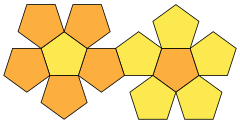
Back شبكة (متعدد أوجه) Arabic Netz (Polyeda) BAR Desenvolupament pla d'un políedre Catalan Нумайхысаклăх сарăмĕ CV Netz (Geometrie) German Reto (pluredro) Esperanto Desarrollo de un poliedro Spanish Patron (géométrie) French פריסה (גאומטריה) HE Jaring (polihedron) ID


In geometry, a net of a polyhedron is an arrangement of non-overlapping edge-joined polygons in the plane which can be folded (along edges) to become the faces of the polyhedron. Polyhedral nets are a useful aid to the study of polyhedra and solid geometry in general, as they allow for physical models of polyhedra to be constructed from material such as thin cardboard.[1]
An early instance of polyhedral nets appears in the works of Albrecht Dürer, whose 1525 book A Course in the Art of Measurement with Compass and Ruler (Unterweysung der Messung mit dem Zyrkel und Rychtscheyd ) included nets for the Platonic solids and several of the Archimedean solids.[2][3] These constructions were first called nets in 1543 by Augustin Hirschvogel.[4]
- ^ Wenninger, Magnus J. (1971), Polyhedron Models, Cambridge University Press
- ^ Dürer, Albrecht (1525), Unterweysung der Messung mit dem Zyrkel und Rychtscheyd, Nürnberg: München, Süddeutsche Monatsheft, pp. 139–152. English translation with commentary in Strauss, Walter L. (1977), The Painter's Manual, New York
{{citation}}: CS1 maint: location missing publisher (link) - ^ Schreiber, Fischer, and Sternath claim that, earlier than Dürer, Leonardo da Vinci drew several nets for Luca Pacioli's Divina proportione, including a net for the regular dodecahedron. However, these cannot be found in online copies of the 1509 first printed edition of this work nor in the 1498 Geneva ms 210, so this claim should be regarded as unverified. See: Schreiber, Peter; Fischer, Gisela; Sternath, Maria Luise (July 2008), "New light on the rediscovery of the Archimedean solids during the Renaissance", Archive for History of Exact Sciences, 62 (4): 457–467, doi:10.1007/s00407-008-0024-z, JSTOR 41134285
- ^ Friedman, Michael (2018), A History of Folding in Mathematics: Mathematizing the Margins, Science Networks. Historical Studies, vol. 59, Birkhäuser, p. 8, doi:10.1007/978-3-319-72487-4, ISBN 978-3-319-72486-7